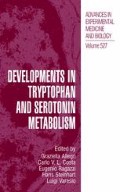Abstract
A widespread occurrence of melatonin in plant kingdom has been reported. The circadian rhythm in the level of melatonin observed in both unicellular algae and higher plants, suggests a role in regulation of photoperiodic and rhythmic phenomena, i.e. a similar function for melatonin in both plants and animals. Evidence has been obtained for a role of melatonin in plant morphogenesis, but more research is needed to ascertain other suggested physiological roles in higher plants (seed dormancy regulation, radical scavenger activity, interaction with calmodulin) as well the ecological significance of the high melatonin levels recorded in alpine plants. Setting-up more reliable analytical methods for melatonin detection and quantification is a basic requirement to get more insight into melatonin roles in plant physiology and ecology.
Access this chapter
Tax calculation will be finalised at checkout
Purchases are for personal use only
Preview
Unable to display preview. Download preview PDF.
References
G.B. West, Tryptamines in edible fruitsJ. Pharm. Pharmacol. 10589–590 (1958).
S. Undenfriend, W. Lovenberg, A. Sjoerdsma, Physiologically active amines in common fruits andvegetables Arch. Biochem. Biophys.85, 487–490 (1959).
I. Balzer and R. Hardeland,. Photoperiodism and effects of indoleamines in a unicellular algaGonyaulax polyedra. Science 253795–797 (1991)
A. Hattori, H. Migitaka, I. Masayaki, M. Itoh, M. Yamamoto, R. Ohtani-Kaneko, M. Hara, I. Suzuki, R.J. Reiter, Identification of melatonin in plants and its effects on plasma melatonin levels and binding to melatonin receptors in vertebratesBiochem. Mol. Biol. Int. 35627–634 (1995).
L. C. Manchester, D.X. Tan, R. J. Reiter, W. Park, K. Monis, W. Qi, High melatonin levels in the seeds of edible plants: possible function in germ cell protectionLife Sci. 673023–3029 (2000).
S. J. Murch, C.B. Simmons, P. K. Saxena, Melatonin in feverfew and other medicinal plantsThe Lancet 3501598–1599 (1997).
C. Tettamanti, B. Cerabolini, P. Gerola, A. Conti, Melatonin identification in medicinal plantsActa Phytotherapeutica III137–144 (2000).
R.J. Reiter, Melatonin: that ubiquitously acting pineal hormoneNew Physiolol. Sci. 6223–227 (1991).
B. Poeggeler, I. Balzer, R. Hardeland, A. Lerch!, Pineal hormone melatonin oscillates also in the dinotlagellateGonyaulax polyedra. Naturewissenschaften 78268–269 (1991).
J. Kolar, I. Machackova, J. Eder, E. Prinsen, W. Van Dongen, H. Van Onckelen, H. Illerova. Melatonin: occurrence and daily rhythm inChenopodium rubrum. Phylochemislry 441407–1414 (1997).
R. Hardeland, A. Coto-Montes, S. Burkhardt, B. K. Zsizsik, Circadian rhythms and oxydative stress in nonvertebrate organism. In:The redox state and cicardian rhythms edited by T.V.D. e. al., (Kluwer Academic Publishers, The Netherlands, 2000). pp. 121–140.
B. Poeggeler, R.J. Reiter, D.X. Tan, L.D. Chen, L.C. Manchester, Melatonin, hydroxyl radical-mediated oxidative damage and aging, A hypotesisJ. Pin. Res. 14151–168 (1993).
D. L. Van Tassel, J. Li, S.D. O’Neill. Melatonin: identification of a potential dark signal in plantsPlant Physiol. 102659 (1993).
J. Kolar, I. Machackova, Melatonin: does it regulate rhythmicity and photoperiodism also in higher plants?Flower. Newsl. 1753–54 (1994).
R. Hardeland and B. Fuhrberg, Ubiquitous melatonin: presence and effects in unicells, plant and animalsTrends Comp. Biochem. Physiol. 225–45 (1996).
R. J. Reiter. Melatonin: lowering the high price of free radicalsNews Physiol. Sci. 15246–250 (2000).
D. L. Van Tassel, J. Li, S. D. O’Neill, Putative regulatory molecules in plants: evaluating melatoninJ. Pineal Res. 311–7 (2001).
D. L. Van Tassel. Identification and quantification of melatonin in higher plants, Ph D. Dissertation, University of California, Davis, CA. (1995)
Editor information
Editors and Affiliations
Rights and permissions
Copyright information
© 2003 Springer Science+Business Media New York
About this chapter
Cite this chapter
Caniato, R., Filippini, R., Piovan, A., Puricelli, L., Borsarini, A., Cappelletti, E.M. (2003). Melatonin in Plants. In: Allegri, G., Costa, C.V.L., Ragazzi, E., Steinhart, H., Varesio, L. (eds) Developments in Tryptophan and Serotonin Metabolism. Advances in Experimental Medicine and Biology, vol 527. Springer, Boston, MA. https://doi.org/10.1007/978-1-4615-0135-0_68
Download citation
DOI: https://doi.org/10.1007/978-1-4615-0135-0_68
Publisher Name: Springer, Boston, MA
Print ISBN: 978-1-4613-4939-6
Online ISBN: 978-1-4615-0135-0
eBook Packages: Springer Book Archive

